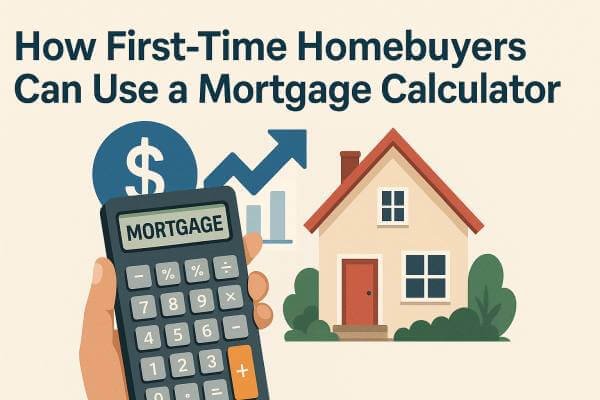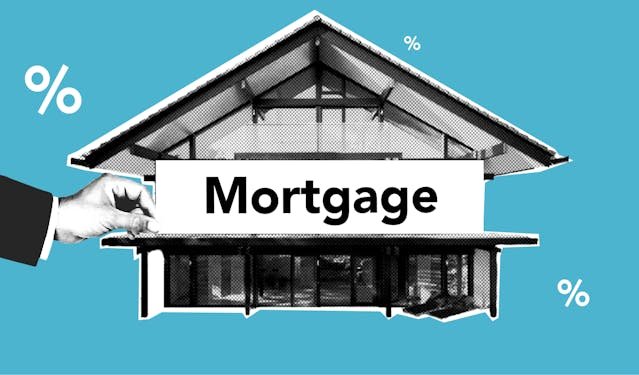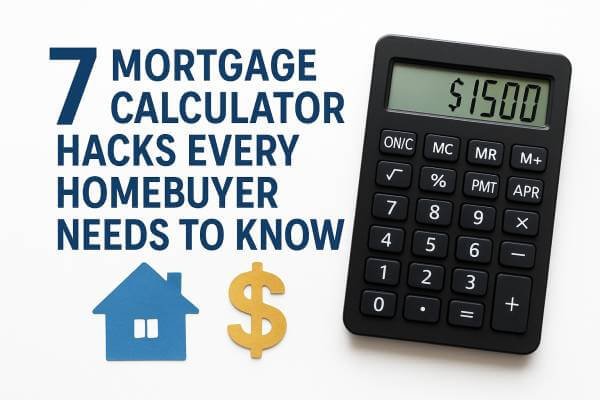How First-Time Homebuyers Can Use a Mortgage Calculator

First-time homebuyers use a mortgage calculator to stop guessing and start planning, and honestly, that’s one of the smartest moves you can make.
Buying your first home is exciting, but it’s also easy to feel overwhelmed by all the numbers flying around. What is the maximum amount you can comfortably afford? What will your monthly payment look like? Will you have anything left over for groceries after the mortgage kicks in?
That’s where a good mortgage calculator comes in. It provides you with a more comprehensive understanding of your financial situation before you become enamoured with an unaffordable house. In this post, I’ll break down exactly how to use one, what numbers to plug in, and how it can help you stay in control of your finances from preapproval to moving day.
Why First-Time Homebuyers Need a Mortgage Calculator
A mortgage calculator is a simple online tool that shows you what your monthly mortgage payment could look like based on a few key numbers: your loan amount, interest rate, down payment, and loan term. Some calculators even factor in property taxes, insurance, and HOA fees.
A mortgage calculator is useful for first-time buyers, as it provides clarity in the midst of uncertainty. It’s crucial to determine your actual affordability before a lender determines your loan amount, which is a significant decision.
Why? Just because you are approved for a loan does not mean that borrowing the full amount is a wise decision. A calculator helps you stay grounded in your budget, not the bank’s.
Let me give you a quick example: Say you’re approved for a $400,000 mortgage. That sounds wonderful, right? But once you calculate the monthly payment, including taxes and insurance, you realize it would eat up nearly 50% of your take-home pay. That’s a red flag.
With a mortgage calculator, you can scale things back and find a number that actually fits your lifestyle and leaves room for, you know, food and furniture.
Key Inputs Every First-Time Homebuyer Should Know
Here’s a quick breakdown of the key inputs every first-time homebuyer needs to know before hitting that “calculate” button:
Home Price
This is the amount you think you’ll pay for the house. You can use a ballpark number here just to get started; nothing has to be exact right away.
Down Payment
This is the cash you plan to put upfront. A typical down payment is around 3% to 20% of the home price. The more you put down, the less you borrow and the smaller your monthly payment.
Loan Amount
Most calculators figure this out for you, but just so you know:
Loan Amount = Home Price – Down Payment
Interest Rate
This is the rate the lender will charge you on the loan. Not sure what to use? Look up the current average mortgage rate online and plug in something close. You can always adjust it later.
Loan Term
Typically, you can choose a loan term of 15, 20, or 30 years. While a shorter term results in higher monthly payments, it also reduces interest over time, which is why most first-time buyers choose a 30-year term.
Property Taxes, Insurance & HOA Fees
These are the extras that sneak up on people. Some calculators include them; others don’t. If yours does, that’s excellent; please add an estimate. If not, be aware that adding these could increase your final payment by a few hundred dollars.
Pro tip: It’s better to overestimate than underestimate. When first-time buyers use a mortgage calculator with realistic (or even slightly padded) numbers, they avoid unpleasant surprises later on.
How First-Time Buyers Use a Mortgage Calculator to Set a Realistic Budget
Now you know what numbers to plug in but how do you actually use a mortgage calculator to build a smart homebuying budget?
Let’s walk through it together.
Step 1: Start with a Target Purchase Price
Pick a price range you think might work for your budget. Don’t worry, this isn’t permanent. Please begin with a realistic starting point based on your area or the listings you have reviewed. Most calculators will ask for this right up front.
Step 2: Add Your Down Payment
Enter how much cash you plan to put down. If you’re not sure yet, try a few different options like 3%, 5%, or 10%. This number can change a lot depending on your savings and loan type.
Step 3: Plug In the Interest Rate and Loan Term
Please utilise the current average rate (which can be found online) or the rate for which your lender pre-qualifies you. Then choose your loan term, usually 30 years for first-time buyers because it keeps the monthly payment lower.
Step 4: Don’t Forget the Extras
If your calculator has fields for taxes, insurance, and HOA fees, use them! Even rough estimates will give you a much more accurate monthly payment.
Step 5: Review the Monthly Payment
This is the crucial step. The calculator displays your estimated monthly payment based on the information you enter. That number is your starting point.
Ask yourself:
- Can I afford this monthly and still cover everything else in my life?
- Will I have room in my budget for unexpected repairs or lifestyle changes?
- What if rates go up before I lock in my loan?
Pro Tip: Adjust Until It Feels Comfortable
Here’s why first-time homebuyers use a mortgage calculator before even talking to a lender: it lets you adjust numbers on your terms.
Try raising the home price. What happens? Try lowering the down payment. Does the monthly jump seem too high?
This is your chance to fine-tune your budget without any pressure.
Mistakes First-Time Homebuyers Make When Using a Mortgage Calculator
Using a mortgage calculator is smart, but only if you use it the right way. Small mistakes often cause significant budgeting problems for first-time buyers.
Let’s go over the most common slip-ups so you can avoid them.
Mistake #1: Forgetting the Extra Costs
Many calculators only show principal and interest, but your mortgage payment is more than that. You also need to budget for:
- Property taxes
- Homeowners insurance
- HOA fees (if applicable)
- Mortgage insurance (if you put down less than 20%)
Pro Tip: Look for calculators that let you add these in or do a quick estimate and tack them on yourself. This can increase your monthly payment by hundreds of dollars.
Mistake #2: Using the Max Purchase Price You’re Preapproved For
Just because the bank says you can borrow $400,000 doesn’t mean you should.
That’s a maximum, not a recommendation.
Here’s the truth: When first-time homebuyers use a mortgage calculator, the goal is to find what they’re comfortable paying, not what the lender allows.
Mistake #3: Ignoring Future Expenses
Maybe your payment looks fine now… but what happens when:
- Your student loan payments kick back in?
- You add daycare costs or a second car?
- You want to travel or build up savings?
Make sure your mortgage leaves room for real life, not just what’s on paper.
Mistake #4: Underestimating the Down Payment Timeline
If you’re planning for a 20% down payment but have only saved $5K, it may present a challenge.
Please consider what you can realistically afford now and the time it will take to achieve your goal.
Mistake #5: Only Running One Scenario
This might be the biggest one: only trying one set of numbers.
Instead, run multiple “what if” versions.
What if rates go up by 1%?
What if you find a house $25K cheaper?
Lastly, what if you go with a 15-year loan instead?
Use a calculator as a tool to experiment and determine the best option for you.
Avoiding these mistakes helps you get a realistic, not just idealistic, view of what homeownership will cost. And when first-time buyers use a mortgage calculator with this mindset, they’re way more likely to stay on track financially.
Tips to Maximize the Value of Your Mortgage Calculator
While using a mortgage calculator is a great start, a few simple tips can significantly enhance your budgeting skills.
Let’s explore the expert use of a mortgage calculator by first-time buyers.
Tip #1: Run Multiple Scenarios
Don’t simply enter a single set of numbers and proceed.
- Different down payment amounts
- 15-year vs. 30-year loans
- Lower vs. higher interest rates
This helps you see how even small changes affect your monthly payment and gives you more confidence when it’s time to make a decision.
Tip #2: Be Honest About Your Finances
It’s tempting to fudge numbers a little (“I might get a raise soon…”), but your calculator can’t give you accurate info if you don’t give it the full picture.
Use your current income, realistic savings, and actual monthly expenses. You’ll thank yourself later.
Tip #3: Aim for a Monthly Payment That’s Comfortable, Not Maxed Out
Just because your budget can stretch doesn’t mean it should. Use the calculator to find a payment that fits with your lifestyle, not one that leaves you house-poor.
First-time homebuyers can prevent future stress and financial strain by using a mortgage calculator to stay within their means.
Tip #4: Double-Check for Taxes and Insurance
Some calculators include them, some don’t. Please ensure you are aware of what is included in the monthly estimate, or consider using a separate calculator that accounts for all factors.
If you skip this step, you could be underestimating your true monthly payment by a lot.
Tip #5: Use It Before You Shop
This one’s huge: run the numbers before you start browsing listings.
Why? Falling in love with a house that exceeds your budget can easily lead to overspending.
A calculator sets your expectations early, so you can house-hunt smarter and avoid heartbreak later.
Ultimately, utilising a mortgage calculator effectively is crucial. Take your time, test different scenarios, and build a budget that’s grounded in reality. You’ll make stronger choices and avoid nasty surprises at closing.
Best Mortgage Calculators for First-Time Buyers
Not all mortgage calculators are the same. While some mortgage calculators focus solely on principal and interest, others provide comprehensive information such as taxes, insurance, PMI, and more.
Here are a few trusted tools that first-time buyers use to budget effectively.
1. NerdWallet Mortgage Calculator
Why it’s excellent: The calculator boasts a clean layout, is highly beginner-friendly, and provides a comprehensive cost breakdown that includes estimated property taxes and homeowners insurance.
Bonus: It updates in real-time as you change numbers.
2. Bankrate Mortgage Calculator
Why it’s helpful: It includes PMI, which many first-time homebuyers forget to factor in. Plus, it shows a full amortization schedule so you can see how much goes to interest vs. principal over time.
3. Zillow Mortgage Calculator
Why it stands out: If you’re browsing homes on Zillow already, you’ll see the estimated mortgage payment right on each listing. It includes taxes and HOA fees and even lets you adjust your down payment on the fly.
4. FHA Mortgage Calculator
Perfect for: Buyers using an FHA loan with a low down payment. It includes upfront mortgage insurance premiums and monthly MIP, two things that matter a lot with this loan type.
5. Mobile Apps – Mortgage Calculator Plus (iOS/Android)
This app is super handy when you’re house hunting in person. You can quickly run numbers from your phone during open houses or meetings with your agent.
When first-time homebuyers use a mortgage calculator from a trusted site (or app), they get clearer, more reliable numbers to base their budget on. The key is finding one that fits your needs, whether that’s simplicity, detail, or mobility.
Pro Tip: Use two or three calculators to compare results. That way, you’ll catch anything one might be missing and feel more confident about the numbers.
What to Do After Using the Mortgage Calculator
So you’ve crunched the numbers. You’ve tested different scenarios. You’ve figured out what you can comfortably afford. Now what?
Here’s what first-time homebuyers should do after using a mortgage calculator to keep the momentum going.
1. Get Preapproved by a Lender
A calculator provides you with an estimate, while a lender verifies your financial situation. By obtaining preapproval, you demonstrate your seriousness to potential sellers and expedite the process when you discover the ideal home.
2. Start House Hunting with Confidence
No more browsing million-dollar homes you wish you could afford. Use your calculator results to narrow down listings that match your budget. You’ll save time and energy and avoid falling in love with something out of reach.
3. Set a Savings Goal (If Needed)
If the numbers showed you need a bigger down payment to hit your ideal monthly payment, don’t stress; just make a plan. Even saving an extra $2,000 can make a difference.
4. Talk to a Mortgage Advisor or Real Estate Agent
If something felt confusing while using the calculator or if you’re unsure what loan type is best for you, a professional can help you make sense of it all. Bring your calculator results with you. It makes the conversation way more productive.
5. Keep Rechecking as Things Change
Interest rates go up and down. Your income might change. Maybe you decide to look in a different neighbourhood.
When first-time homebuyers use a mortgage calculator regularly throughout the homebuying journey, they stay flexible and avoid surprises.
The bottom line is that your mortgage calculator was step one. Now it’s time to take what you’ve learnt and move toward the fun part: finding your first home.
Conclusion
Buying your first home is about what fits your life and budget, not just what the bank says you can afford. That’s exactly why first-time homebuyers use a mortgage calculator before making any big moves.
With just a few numbers, you can go from guessing to knowing, and that’s powerful. You’ll avoid financial stress, shop with confidence, and make smarter decisions from the start.
So go ahead, run the numbers. Play with the “what-ifs.” Find your comfort zone. The right home is out there, and now, you’ll be ready for it.
FAQ
1. What is the best mortgage calculator for first-time homebuyers?
The best mortgage calculators for first-time homebuyers are ones that include taxes, insurance, and PMI, like NerdWallet, Bankrate, or Zillow’s tools.
2. How accurate are mortgage calculators?
Mortgage calculators provide reliable estimates; however, they may not account for every potential cost. It is advisable to use them for budgeting purposes and verify the figures with a lender.
3. Why should first-time homebuyers use a mortgage calculator?
It assists in determining a feasible home budget and monthly installments and prevents overcommitting prior to engaging with a lender.
4. How much house can I afford as a first-time buyer?
It depends on your income, debt, down payment, and interest rate. A mortgage calculator can help estimate a comfortable price range for you.
5. Should I trust the monthly payment shown on listings?
Not always. Those estimates often leave out taxes or insurance. It’s better to run your own numbers with a full-featured mortgage calculator.


























